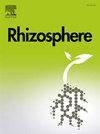Functional profiling of abundant glycosyltransferases in the rhizospheric bacteriome of Abutilon fruticosum
IF 3.4
3区 生物学
Q1 PLANT SCIENCES
引用次数: 0
Abstract
In this study, we undertook an extensive exploration of the rhizospheric bacteriome of Abutilon fruticosum, focusing on the activities of Carbohydrate-Active Enzymes (CAZymes) of class glycosyltransferases (GTs), and their potential impact on plant growth and fortification against environmental adversities and soil-borne pathogens. Investigation revealed a predominance of families GT1, GT31, GT35, GT39, and GT51, mainly ascribed to bacterial genera Microvirga, Arthrobacter, Blastococcus, Bacillus, Nocardioides, and Kocuria. Our findings unveiled the pivotal role of phenylalanine, mostly exuded by plant roots, serving as the primary substrate for the catalytic activities of the identified CAZymes. With glucosylation emerging as the predominant enzymatic function, we propose UDP-D-glucose as the central core intermediate metabolite, orchestrating a multifaceted network of interrelated metabolic pathways. Subsequent profiling delineated a diverse array of metabolites synthesized by 10 CAZymes actively participating in 10 crosstalking pathways. Functional analyses of these metabolites underscore their significance in the biosynthesis of flavonoids, anthocyanins, and related derivatives, crucial for the reproductive success of plants by serving as visual cues for insect pollinators and conferring protection against deleterious effects of radiation. Certain other metabolites play vital roles in reinforcing the structural integrity of plant cell walls, thus enhancing resistance against enzymatic degradation while augmenting cytokinin activity. In conclusion, our study elucidates a novel paradigm of plant-bacteria mutualistic interaction, offering insights into the intricate mechanisms underlying plant-microbe symbiosis. We posit that the integration of high-throughput technologies with metabolic engineering strategies presents a promising approach for applying cost-effective and environmentally benign alternatives to conventional agricultural practices. (249 words).
求助全文
约1分钟内获得全文
求助全文
来源期刊

Rhizosphere
Agricultural and Biological Sciences-Agronomy and Crop Science
CiteScore
5.70
自引率
8.10%
发文量
155
审稿时长
29 days
期刊介绍:
Rhizosphere aims to advance the frontier of our understanding of plant-soil interactions. Rhizosphere is a multidisciplinary journal that publishes research on the interactions between plant roots, soil organisms, nutrients, and water. Except carbon fixation by photosynthesis, plants obtain all other elements primarily from soil through roots.
We are beginning to understand how communications at the rhizosphere, with soil organisms and other plant species, affect root exudates and nutrient uptake. This rapidly evolving subject utilizes molecular biology and genomic tools, food web or community structure manipulations, high performance liquid chromatography, isotopic analysis, diverse spectroscopic analytics, tomography and other microscopy, complex statistical and modeling tools.
 求助内容:
求助内容: 应助结果提醒方式:
应助结果提醒方式:


